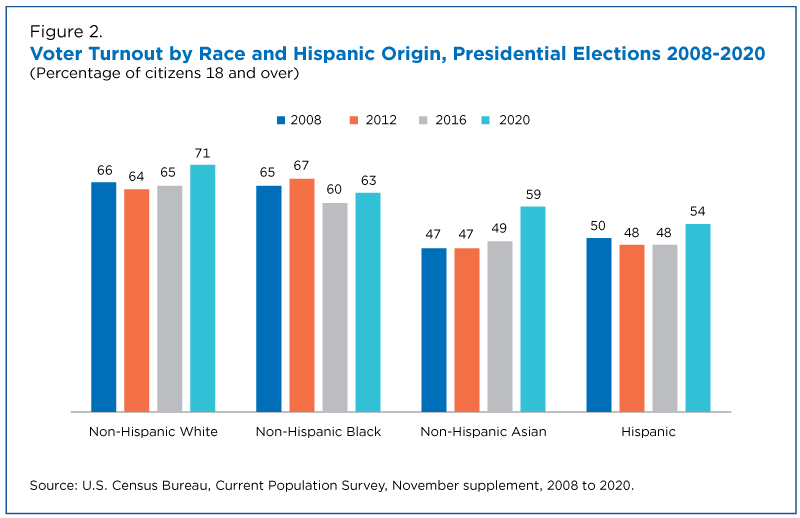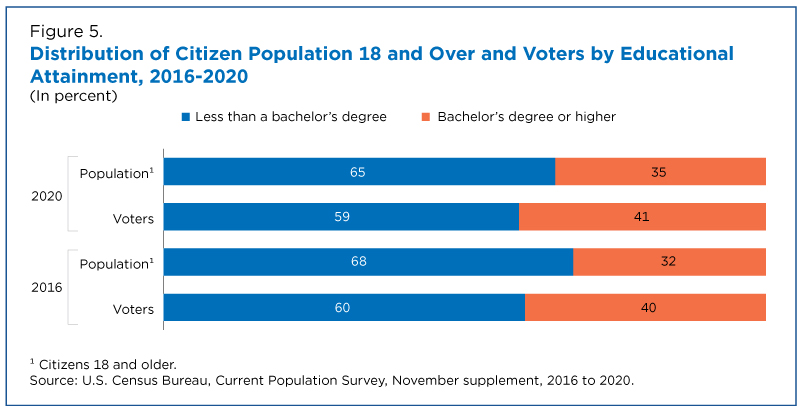Despite Pandemic Challenges, 2020 Election Had Largest Increase in Voting Between Presidential Elections on Record
Despite unique challenges to voter registration and voting created by COVID-19 and heightened concerns about turnout as a result, the 2020 election had the highest voter turnout of the 21st century.
The 2020 election featured the largest increase in voters between two presidential elections on record with 17 million more people voting than in 2016.
The COVID-19 pandemic did not prevent Americans from registering and voting at relatively high rates.
In 2020, 67% of all citizens age 18 and older reported voting, up 5 percentage points from 2016 (Figure 1).
Only citizens — U.S.-born or naturalized — age 18 or older are eligible to vote.
In addition, 73% of all voting-age citizens were registered to vote, 2 percentage points higher than in 2016.
The COVID-19 pandemic did not prevent Americans from registering and voting at relatively high rates. Only 2% of citizens 18 and older who did not register to vote reported not registering because of concerns about the COVID-19 pandemic and only 4% of registered nonvoters reported not voting due to such concerns.
Many voters used alternative voting methods and there was a large shift to early voting and voting by mail.
These statistics come from new data released today from the Current Population Survey's November 2020 Voting and Registration Supplement. This supplement asked noninstitutionalized civilians about their voting and registration behavior in the 2020 presidential election.
Due to the nature of survey responses, these estimates may differ from administrative reports and estimates from other data sources. However, this supplement provides a unique look at the characteristics of American voters.
Higher Turnout Across All Race Groups
Turnout rates in 2020 were higher than in the 2016 election for non-Hispanic White, non-Hispanic Black, non-Hispanic Asian, and Hispanic race and origin groups.
The largest increase was for non-Hispanic Asians (Figure 2). Of the non-Hispanic Asian population who were both citizens and of voting age, 59% reported voting in 2020, compared to 49% in 2016.
Non-Hispanic Asian registration saw a large increase as well: 64%, compared to 56% in 2016. The 2020 election also featured higher turnout rates for:
- Non-Hispanic Whites: 71% voter turnout, compared to 65% in 2016.
- Hispanics: 54%, compared to 48% in 2016.
- Non-Hispanic Blacks: 63%, compared to 60% in 2016. While voter turnout in this group was higher than in 2016, it did not exceed turnout in 2008 (65%).
In previous elections, non-Hispanic Black voter turnout far exceeded non-Hispanic Asian turnout by 18 percentage points in 2008 and by 20 points in 2012.
In contrast, non-Hispanic Black voter turnout in 2020 was only 3 percentage points higher than non-Hispanic Asian turnout.
Turnout by Sex and Age
In 2020, 68% of women eligible to vote reported voting — higher than the 65% turnout for men.
In the 2016 election, 63% of women and 59% of men reported voting.
Voting rates were higher in 2020 than in 2016 across all age groups, with turnout by voters ages 18-34 increasing the most between elections:
- For citizens ages 18-34, 57% voted in 2020, up from 49% in 2016.
- In the 35-64 age group, turnout was 69%, compared to 65% in 2016.
- In the 65 and older group, 74% voted in 2020, compared to 71% in 2016.
Population Shifts and Turnout
Changes in the nation’s population makeup also play a role in voter turnout.
Take for example, the non-Hispanic White alone population, a group that tends to vote at a higher rate than other groups.
The share of the citizen voting-age population that is non-Hispanic White declined from 69% in 2016 to 67% in 2020 (Figure 3). At the same time, the non-Hispanic White share of voters declined as well, from 73% in 2016 to 71% four years later.
Still, their voter turnout rate exceeded their share of the voting population: non-Hispanic Whites were 71% of voters but only 67% of citizens 18 and older.
For the first time, Hispanic voters surpassed the 10% mark in a presidential election. In 2020, they made up 11% of the total turnout, close to the non-Hispanic Black share of 12%.
As the U.S. population ages, the share of older voters is also growing (Figure 4). People over the age of 65 made up 23% of the citizen voting-age population in 2020, up from 21% in 2016. They now make up 26% of all voters, up from 24% in the previous presidential election.
The population is diversifying and getting older but also more educated (Figure 5).
People with a bachelor’s degree or higher were 32% of the citizen voting-age population in 2016 and 35% in 2020. Their share of the voting population went from 40% to 41% during that time.
In contrast, the share of citizens 18 and older with less than a bachelor’s degree went down from 68% in 2016 to 65% in 2020. Their share of voters went from 60% to 59% during the same period but still remained the largest voting bloc.
Voter turnout for both groups increased in 2020. However, turnout for voters with less than a bachelor’s degree increased at a higher rate: 60% in 2020 compared to 54% in 2016. Among voters with a bachelor’s degree or more, turnout in 2020 was 80%, up from 76% in 2016.
These changes to turnout and demographics are some of the unique aspects of a presidential election that, despite the COVID-19 pandemic, was ultimately a high turnout election.
Note: Additional information on confidentiality protection, sampling error, nonsampling error and definitions is available.
Jacob Fabina is an economist in the U.S. Census Bureau’s Social, Economic, and Housing Statistics Division.
Data > Tables
Story Ideas and Statistics
-
Voting and RegistrationIn election years, the Current Population Survey collects data on reported voting and registration, and later reports stats by turnout, age, race and origin.
-
VisualizationHistorical Apportionment Data Map (Interactive)This interactive tool enables users to view more than 10 decades of apportionment and population data.
-
Stats for StoriesPresidents’ Day: February 19, 2024Observed the third Monday of February, the day honors all former U.S. presidents. President Washington was born Feb. 22, 1732. Lincoln was born Feb. 12, 1809.
Subscribe
Our email newsletter is sent out on the day we publish a story. Get an alert directly in your inbox to read, share and blog about our newest stories.
Contact our Public Information Office for media inquiries or interviews.
-
America Counts StoryWhat Methods Did People Use to Vote in the 2020 Election?April 29, 2021New data from the Current Population Survey’s voting supplement examine voting methods in 2020 and changes from 2016 at the national and state levels.
-
America Counts StoryWhat Recent Elections Tell Us About the American Voter TodayOctober 05, 2020In the last presidential election, 70% of the voting-eligible population registered to vote and 61% voted. Almost 9 in 10 registered voters cast a ballot.
-
America Counts StoryBehind the 2018 U.S. Midterm Election TurnoutApril 23, 2019New Census Bureau data show that voting increased among all voting age and major racial and ethnic groups.
-
Business and EconomyWhat Is the Nonemployer Marine Economy?April 09, 2025Thirty states had nonemployer businesses in marine economy sectors, including six states in the Midwest with receipts totaling nearly $11 billion in 2022.
-
Business and EconomyEconomic Census Geographic Area Statistics Data Now AvailableApril 07, 2025A new data visualization based on the 2022 Economic Census shows the changing business landscape of 19 economic sectors across the United States.
-
Income and PovertyWhat Sources of Income Do People Rely On?April 02, 2025A new interactive data tool shows income sources for hundreds of demographic and economic characteristic combinations.
-
Business and EconomyBig Improvements to the Annual Integrated Economic Survey (AIES)March 26, 2025The Census Bureau is making several changes and enhancements to capture 2024 economic data based on feedback from last year’s survey.











